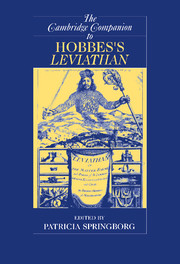Book contents
- Frontmatter
- General Introduction
- Part I: Of Man
- 1 Thomas Hobbes’s Visual Strategies
- 2 Leviathan, the Beast of Myth: Medusa, Dionysos, and the Riddle of Hobbes’s Sovereign Monster
- 3 Sense and Nonsense about Sense: Hobbes and the Aristotelians on Sense Perception and Imagination
- 4 Hobbes on the Natural Condition of Mankind
- 5 Hobbes’s Moral Philosophy
- Part II: Of Commonwealth
- Part III: Of a Christian Commonwealth
- Part IV: Of the Kingdom of Darkness
- Part V: Hobbes’s Reception
- Bibliography
- Index
- Series List
1 - Thomas Hobbes’s Visual Strategies
from Part I: - Of Man
Published online by Cambridge University Press: 28 November 2007
- Frontmatter
- General Introduction
- Part I: Of Man
- 1 Thomas Hobbes’s Visual Strategies
- 2 Leviathan, the Beast of Myth: Medusa, Dionysos, and the Riddle of Hobbes’s Sovereign Monster
- 3 Sense and Nonsense about Sense: Hobbes and the Aristotelians on Sense Perception and Imagination
- 4 Hobbes on the Natural Condition of Mankind
- 5 Hobbes’s Moral Philosophy
- Part II: Of Commonwealth
- Part III: Of a Christian Commonwealth
- Part IV: Of the Kingdom of Darkness
- Part V: Hobbes’s Reception
- Bibliography
- Index
- Series List
Summary
PICTURE WARS
The conflicts of the last five years have been waged at least in part as a war of images. From the destruction of the Buddha statues of Bamijan, the attack on New York's Twin Towers, the toppling of the statues of Saddam Hussein in Iraq, the videos of torturing and beheadings, to the caricature conflict of early 2006, the phrase 'shock and awe', which rhetorically announced the military campaign in Iraq of 2003, was deeply embedded. While 'shock' is a central concept of the avant-garde aesthetic, the term 'awe' is a product of the linguistic power of the antirhetorician Thomas Hobbes. According to a seminal phrase from his Leviathan, contracts are constantly in danger of being broken by the contracting parties 'when there is no visible Power to keep them in awe'. Whether Hobbes would in 2003 have rightly used the term 'awe', or have simply found this a case of usurpation, the fact remains that the present war of images shows that theories that ignore the power of images as hypothesized by Hobbes miss an essential if not a decisive political-historical moment. But the examples provided by recent history are distinctly different from Hobbes's picture-theory of politics, in seeking to fulfill their mission of awe through destruction. For Hobbes, images achieve their political function not through acts of iconoclasm or image-producing human sacrifice but rather by deterring destruction. Through the 'terror' of their pictorial power, they support those authorities that are in a position to punish destruction.
- Type
- Chapter
- Information
- The Cambridge Companion to Hobbes's Leviathan , pp. 29 - 60Publisher: Cambridge University PressPrint publication year: 2007
- 31
- Cited by



